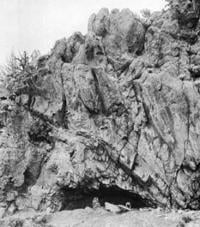Published Friday February 24, 2006
By LEE JUILLERAT
H&N Regional Editor
Linsie Lafayette is searching for clues.
This week she's in Klamath Falls, spending her days in a second floor room at the Favell Museum, her eyes pressed against a stereo microscope.
She zooms the scope in and out while studying individual obsidian points, which are firmly clamped in position and illuminated with two narrow but intense beams of light.
The artifacts were created and used 8,000 to 11,000 years ago by nomadic aboriginal tribes that traveled sections of what is now Oregon's high desert, including lands of far northern Lake County.
She believes the points were originally used on spears or other projectiles, then possibly later recycled as knives or scrapers.
“They were being very economical with their stone tools,” Lafayette speculates. “They're significant because they indicate they were very mobile and didn't want to carry a lot of weight, as opposed to those who lived in village sites who had different tools for different tasks.”
Lafayette, 29, is traveling to museums in Oregon and Nevada in search of clues about the lifestyles of early aboriginal Indians. It's part of a master's thesis she's doing for the University of Nevada at Reno.
The Favell Museum is the focal point of her studies because of its celebrated collection of points collected from the Cougar Mountain Cave.
The cave is in northern Lake County's Fort Rock Valley, about 11 miles from the Fort Rock Cave where 1938 digs by Dr. Luther Cressman proved the region was periodically inhabited more than 9,000 years ago.
“It's a famous cave,” Lafayette said. “It's probably the largest collection of these types of points found in a cave.”
Weapons, tools, implements, bits of clothing and other artifacts taken from the cave during 1958 digs by John Cowles are well preserved partly because they come from the cave's relatively protected environment.
“So many things happen to them when they're on the surface,” Lafayette said, citing damage created by weather, erosion and human impacts over thousands of years. “They're more pristine.”
The late Gene Favell bought the Cougar Mountain Cave artifacts from Cowles.
Other collections Lafayette plans to study include those from the Hanging Rock Shelter and Lost Supper Cave, both at the Nevada State Museum, and from Newberry Crater at the University of Oregon.
“I was very happy to find all the points that had been photographed and published in the '70s,” she said of the Cougar Mountain Cave collection. “Sometimes they get lost or are not very well organized.”
Museum curator Pat McMillan hopes Lafayette's studies will be the start of ongoing investigations of museum items. Information encouraging future studies are planned on the Favell's Web site.
“There are a lot of scholars who know what we have here,” McMillan said. “We hope to welcome other researchers.”
Lafayette's research began earlier this week. She hopes to wrap up her studies of 35 selected points by today.
It's a tedious but productive process. She spends about an hour per projectile, studying and photographing with a digital camera attached to the microscope, which shows images in three dimensions.
She's curious because there are four types of stemmed points associated with the time period 8,000 to 11,000 years ago - the Cougar Mountain, Haskett, Parman and Windust. Unusually, all four types were collected from the Cougar Mountain Cave. The time period is significant because it's associated with the “peopling of America.”
“These different types are a mystery because why would they have four different types all in the same time period?” Lafayette said.
Before beginning her research, she had flintknappers make replicas of the different points. Some were put on spears and thrown at targets. Others were used as knives to butcher a deer.
Those provided her with control samples that provide insight into understanding the use and wear of the historic points.
Lafayette believes the points were reshaped and reused for different purposes.
“No one has really proved or disproved this hypothesis,” she said.
It's too soon to know what her research will find - “I haven't studied enough to make any generalizations.”




